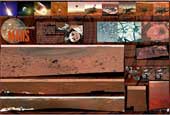
 |
|
|
|
Organised by destination (in order: the Moon, Venus, Mars, giant planets, Mercury, the Sun, comets, dwarf planets and asteroids), the sequence at first seemed a little haphazard and given the title I expected the missions to appear to chronological order. It soon became clear that the planetary objects at least are presented in the order in which humans sent probes there (for those who like to follow timelines there’s a handy chronological chart in the appendix). The book opens with an overview of how probes are launched, and a brief history of rocketry and spaceflight. I was impressed with how up to date it was. I tried to catch it out with the StardustNEXT flyby of Comet Tempel 1 in 2011 but that was included, as was the EPOXI fly-by of comet Hartley 2 at the end of 2010 and Rosetta’s fly-by of asteroid Lutetia in the summer of 2011. I even found a mission I’d never even heard of before – the Japanese Hiten–Hagoromo mission of the early 1990s that looped around the Earth–Moon system. Although aspects of the mission did not go to plan, the Hiten probe was deliberately crashed into the Moon in 1993 and in doing so Japan became the third nation after the Soviets and Americans to send a probe to the Moon. Some missions (like Hiten–Hagoromo) are described in just one page, while more successful missions, particularly the plethora of Mars orbiters and landers, have multiple pages dedicated to them, including many spectacular full-page colour images, details of the spacecraft’s trajectory and images of the hardware and launch. This was, thankfully, not the heavy-going encyclopedic tome I had been expecting before opening the book, but an easy to read and accessible story of space exploration. I was surprised to learn that Space Probes was compiled by a professor of neuroscience, but Séguéla lays any concerns to rest in this opening note, where I rather liked the way he drew parallels between the human body’s nervous system to the relay switches and high resolution digital ‘retinas’ in space probes. Emily Baldwin |
|
|
|
2009 Yearbook This 132-page special edition features the ultimate observing guide for 2009, a review of all the biggest news stories of 2008, in depth articles covering all aspects of astronomy and space missions for 2009, previews of International Year of Astronomy events and much, much more. This 132-page special edition features the ultimate observing guide for 2009, a review of all the biggest news stories of 2008, in depth articles covering all aspects of astronomy and space missions for 2009, previews of International Year of Astronomy events and much, much more.Infinity Rising  This special publication features the photography of British astro-imager Nik Szymanek and covers a range of photographic methods from basic to advanced. Beautiful pictures of the night sky can be obtained with a simple camera and tripod before tackling more difficult projects, such as guided astrophotography through the telescope and CCD imaging. This special publication features the photography of British astro-imager Nik Szymanek and covers a range of photographic methods from basic to advanced. Beautiful pictures of the night sky can be obtained with a simple camera and tripod before tackling more difficult projects, such as guided astrophotography through the telescope and CCD imaging.Exploring Mars  Astronomy Now is pleased to announce the publication of Exploring Mars. The very best images of Mars taken by orbiting spacecraft and NASA's Spirit and Opportunity rovers fill up the 98 glossy pages of this special edition! Astronomy Now is pleased to announce the publication of Exploring Mars. The very best images of Mars taken by orbiting spacecraft and NASA's Spirit and Opportunity rovers fill up the 98 glossy pages of this special edition!Mars rover poster  This new poster features some of the best pictures from NASA's amazing Mars Exploration Rovers Spirit and Opportunity. This new poster features some of the best pictures from NASA's amazing Mars Exploration Rovers Spirit and Opportunity. |
||||||||||||||||||||||||